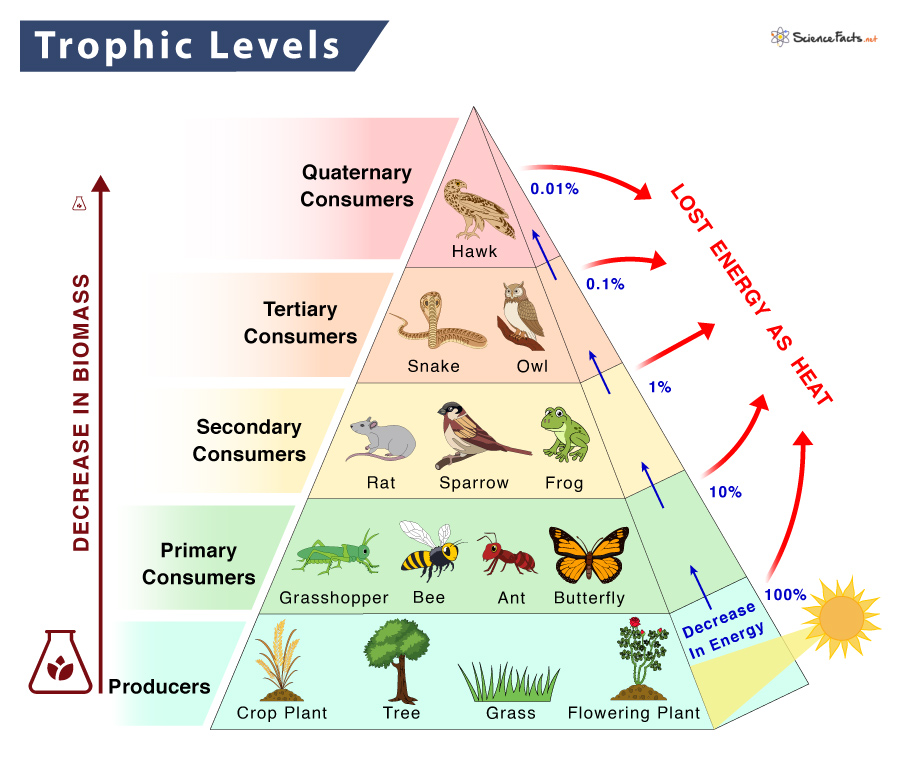Trophic Level
The trophic levels refer to the position of a group of organisms in the food chain, food web, or ecological pyramid based on their feeding pattern. They are shown in a series or a succession to represent energy flow from one tropic level to another. The position of the trophic level depends upon the number of steps the organism takes from the start of the food chain until its consumption.
All food chains start with the producer, which occupies the bottom of the food chain and thus is at the first trophic level. All food chains end with the apex consumer, whose trophic level depends on its prey. For example, it is at the third trophic level if it consumes a primary consumer. If it feeds on a tertiary consumer, it is at the fourth trophic level.
The Five Trophic Levels With Examples
There are five trophic levels in a food chain. They are listed below with examples and food sources.
| Trophic Level | Food Source | Examples |
|---|---|---|
| First Trophic Level | Prepares their food | Green plants and algae |
| Second Trophic Level | Feeds on producers | Grasshoppers, butterflies, deer, and cows |
| Third Trophic Level | Feeds on primary consumers | Frogs, rats, mice, and sparrow |
| Fourth Trophic Level | Feeds on secondary consumers | Snake, owl |
| Fifth Trophic Level | Feeds on tertiary consumers | Hawk |
First Trophic Level: Producers
All food chains and ecological pyramids start with producers. They are found at the base or the first trophic level. Producers are autotrophic organisms that make their food using the sun’s energy. Green plants, algae, and autotrophic bacteria are examples of autotrophs.
The rest of the trophic levels above the consumers are heterotrophs. They cannot prepare their food and depend on producers to acquire nutrition. Consumers are of three types, herbivores, carnivores, and omnivores.
Second Trophic Level: Primary Consumers
The second trophic level above the producers consists of herbivores. These organisms feed on producers and are called primary consumers. Grasshoppers, butterflies, insects, and herbivorous animals like cows, goats, and pigs are examples of primary consumers.
Third Trophic Level: Secondary Consumers
Carnivores and omnivores occupy the following successive levels. Carnivores feed only on other animals, whereas omnivores eat plants and animals. Frogs, rats, mice, and some birds, like sparrows, are an example of secondary consumers.
Trophic level three consists mostly of omnivores that feed on producers and primary consumers and are secondary consumers.
Fourth Trophic Level: Tertiary Consumers
Next to the secondary consumers at the fourth trophic level are the tertiary consumers, primarily carnivores, which prey on secondary consumers. Carnivorous animals like foxes, coyotes, and mountain lions are typical tertiary consumers.
Sometimes, tertiary consumers are apex predators such as lions and foxes.
Fifth Trophic Level: Quaternary Consumers
Further up at the fifth tropic level at the top of the ecological pyramid are the quaternary consumers that feed on tertiary consumers. Quaternary consumers are mostly apex predators with no natural predators and thus die of natural death. Tigers, lions, Foxes, and hawks are examples of quaternary consumers that are also apex predators.
Many consumers, like humans, feed at more than one trophic level. Thus, humans are primary consumers when they eat vegetables. However, they are secondary consumers when they consume cows, goats, and pigs and are tertiary consumers when they eat salmon.
Which Trophic Level is Most Vulnerable to Extinction
In any ecosystem, the top predators are most vulnerable to extinction. Depending on the food chain, they can be found in the fourth or fifth tropic level.
What Trophic Level are Decomposers
Decomposers or detritivores consume the dead and decaying organic matter of plants and animals and thus clean up the ecosystem. However, they do not occupy any particular trophic level as they do not interact with any food chain organisms.
Trophic Levels and Energy
Energy is transferred from lower to higher tropic levels of the food chain. However, only about 10 percent of the energy at one level is passed to the next level. The rest is lost as heat or is used during metabolism. Thus, the first trophic level has the most energy, and the fifth tropic level has the least.
Assume that the available energy in the first trophic level is 1,000 kilocalories. Then the successive tropic levels will have 100 kilocalories, 10 kilocalories, 1 kilocalorie, and 0.1 kilocalories of energy.
Due to this energy loss, only a few food chains have more than four tropic levels. Thus, when the trophic levels are stacked one above the other, it takes a pyramidal shape. It is the energy pyramid or ‘Eltonian Pyramid,’ as Charles Elton conceived it in 1927.
Trophic Levels and Biomass
Later, the concept of an energy pyramid was applied to represent the biomass of the organisms at each tropic level. With less energy at each tropic level, fewer organisms exist at each successive level. Thus, the first trophic level has the most biomass, decreasing as we move up.
The pyramid that represents the above data is called the pyramid of biomass.
-
References
Article was last reviewed on Tuesday, February 21, 2023




